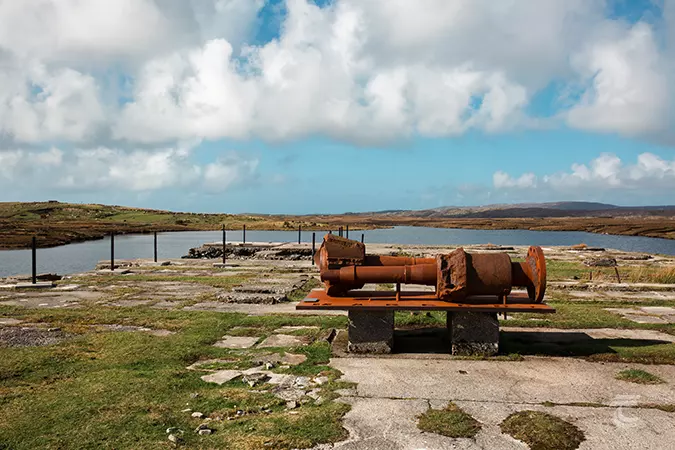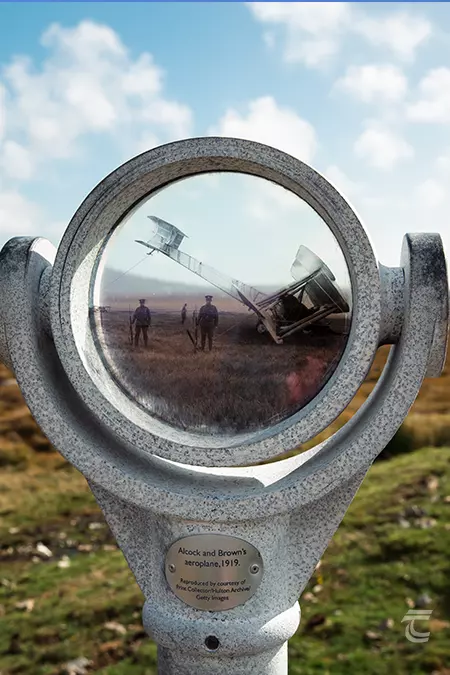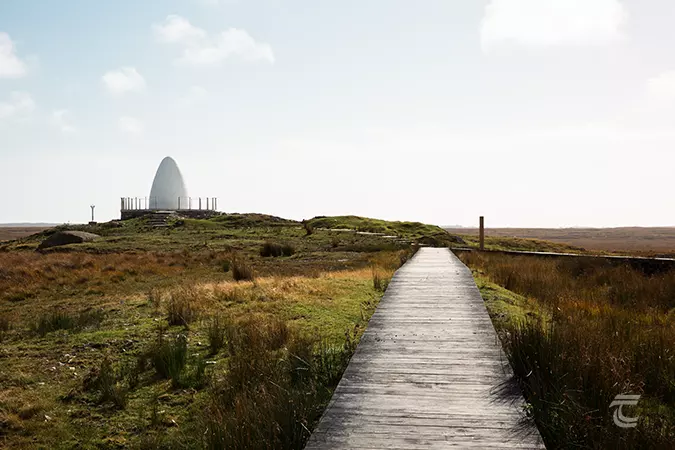Derrigimlagh Bog
Derrigimlagh derives from the Irish Dheirgimligh, a compound of dearg ‘red’ and imleach ‘marshy (shore-)land’. A fitting description for Derrigimlagh’s haunting landscape of lowland blanket bog near the Connemara Coast. It is one of Ireland’s most important industrial heritage and communications landscapes, made famous when it was chosen by the Italian inventor Guglielmo Marconi to construct the world’s first permanent transatlantic radio station. It was from here that he transmitted the very first transatlantic radio signal in 1907. At its peak, hundreds of workers were stationed in this remote landscape. Unfortunately the station was burned and largely destroyed during the War of Independence, though the foundations of many of the buildings can still be seen today.
A white aeroplane wing sculpture stands as a memorial to the daring aviators John Alcock and Arthur Whitten Brown, who crash landed into Derrigimlagh Bog in 1919 at the end of the first non-stop flight across the Atlantic. They had taken off from Newfoundland in a Vickers Vimy biplane, and flew for over 16 continuous hours over 1,890 nautical miles above the Atlantic, braving technical malfunctions, fog and inclement weather before reaching Derrigmlagh. They were uninjured in the crash landing, and as Alcock clambered from the aircraft he proclaimed “Yesterday I was in America, I am the first man in Europe to say that”.
For practical information about visiting this site Click Here
Derrigimlagh derives from the Irish Dheirgimligh, a compound of dearg ‘red’ and imleach ‘marshy (shore-)land’. A fitting description for Derrigimlagh’s haunting landscape of lowland blanket bog near the Connemara Coast. It is one of Ireland’s most important industrial heritage and communications landscapes, made famous when it was chosen by the Italian inventor Guglielmo Marconi to construct the world’s first permanent transatlantic radio station. It was from here that he transmitted the very first transatlantic radio signal in 1907. At its peak, hundreds of workers were stationed in this remote landscape. Unfortunately the station was burned and largely destroyed during the War of Independence, though the foundations of many of the buildings can still be seen today.
A white aeroplane wing sculpture stands as a memorial to the daring aviators John Alcock and Arthur Whitten Brown, who crash landed into Derrigimlagh Bog in 1919 at the end of the first non-stop flight across the Atlantic. They had taken off from Newfoundland in a Vickers Vimy biplane, and flew for over 16 continuous hours over 1,890 nautical miles above the Atlantic, braving technical malfunctions, fog and inclement weather before reaching Derrigmlagh. They were uninjured in the crash landing, and as Alcock clambered from the aircraft he proclaimed “Yesterday I was in America, I am the first man in Europe to say that”.
For practical information about visiting this site Click Here

Derrigimlagh Bog • Connemara
Crossing the Bog
The recently installed and well-interpreted series of trails allows for easy access through the bog, and passes by some of the many lakes and still bog pools. We recommend trying the innovative binocular-style information points that allow you to view the landscape as it once was during the heyday of the communications centre.
Upper left: A turbine engine, part of the bog’s aviation history • Lower left: Path to Alcock and Brown Memorial • Right: View through a historioscope
Top: A turbine engine, part of the bog’s aviation history • Middle: View through a historioscope • Bottom: Path to Alcock and Brown Memorial
Explore more sites on the Wild Atlantic Way




